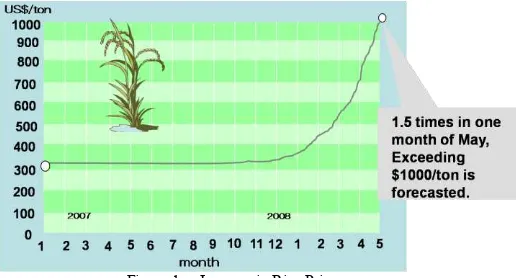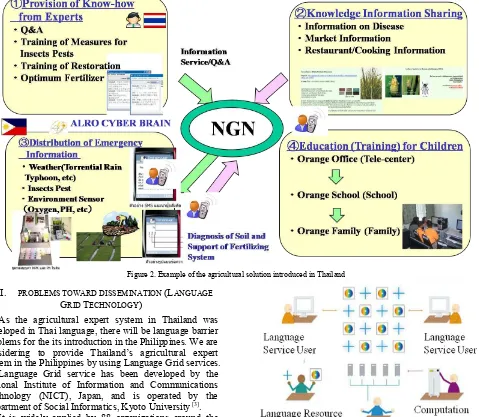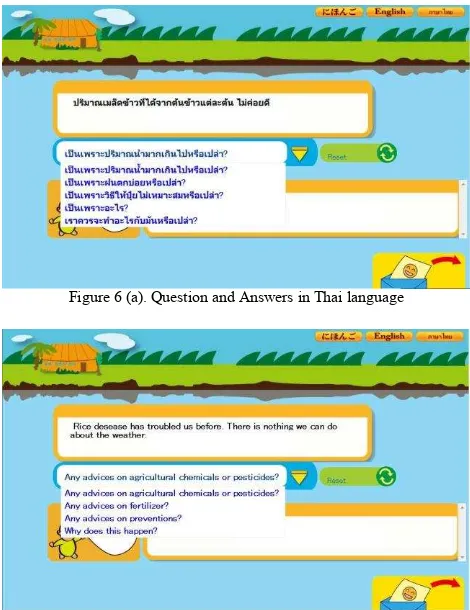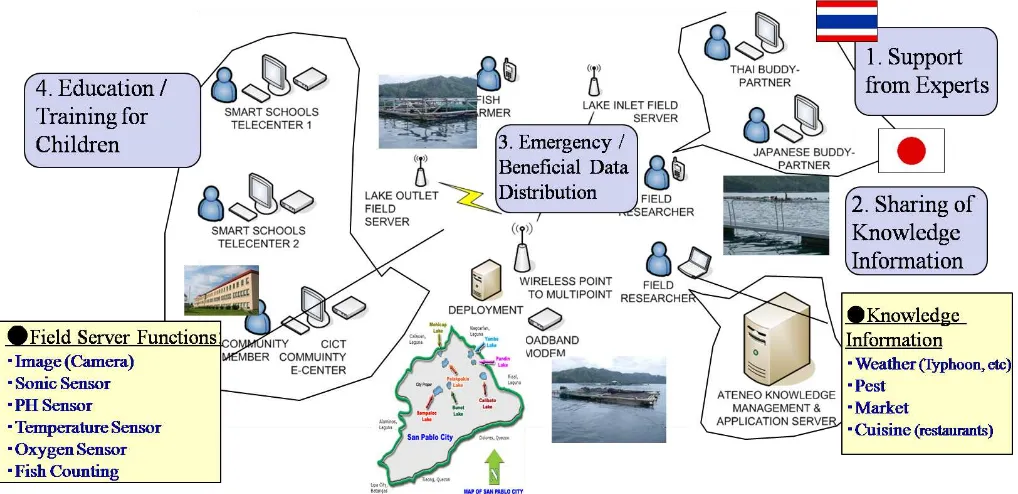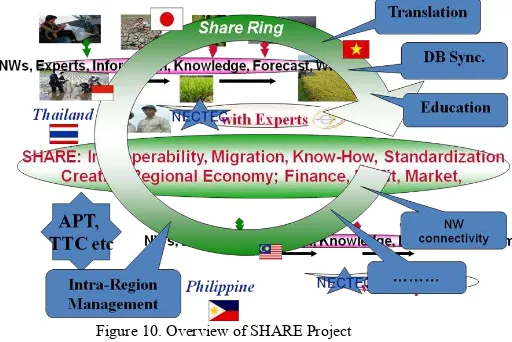Implementation of Thailand
’
s Agricultural Expert System Framework
Abstract— Under the auspices of Telecommunication Technology Committee (TTC) with its slogan “LET’s SHARE (Success & Happiness by Activating Regional
Economy) Together”, constructions of data communication
infrastructure have taken place in remote rural areas of several Asian countries and pilot application solutions to meet local needs in fields such as agriculture, education, health care and environment have been provided. Here we report on the implementation in the Philippines of an agricultural solution in Thailand.
The Philippines is at present the world’s largest importer of rice and in the first half of 2008 when this project was launched the sudden steep rise in the price of rice due to shortages was causing problems for the communities.
The agricultural solution in Thailand consist of recommendation of fertilizer for soil using SMS, suggestion from experts delivered by the network, knowledge database and education system for children. Visitation to the project site was conducted and discussion on the viability of introducing the framework of the Thai agricultural solution in the Philippines was made.
The key exchange technology being used is the language-grid technology. Among our findings, agricultural problems are very important but it has also been suggested that overcoming problems in the fishery business is also important for the Philippines.
Keywords-component; Knowledge, ICT, Telecommunications, rural area, database, education, usability, multilanguage, standards
I. INTRODUCTION
TTC Promotion committee with its slogan: 刴Let‟s SHARE together刵(SHARE: Success & Happiness by Regional Economy) has been implementing data telecommunication infrastructure construction and local needs customized agriculture, education, healthcare, environment and etc applications pilot projects in several countries in Asia. At the same time, TTC promotion committee also conducts activities that supports the deployment of the result of the pilot projects to the surrounding countries. TTC promotion committee is established in 2007 by Japanese major carriers and vendors. Its philosophy is to contribute to the happiness of
Asia-Pacific people and society by appropriate sharing of limited resources and using them as effectively as possible. Its vision is to contribute to the development of ICT and the standards originated from Asia towards NGN era. Its mission is to the promotion and development of system & solution towards bridging economical gap/regional disparities/ standardization gap.
Figure 1. Increase in Rice Price
(Source: Thai national merchandise trade committee and export restrictions)
Figure 1 refers to rice prices in Thailand from the board of trade of Thailand. The prices were expected to increase by 1.5 times, exceeding 1000 US Dollars/ton by May 2008 due to rice export restriction in India and Vietnam. The population of Philippines is approximately 90 million people, with annual rice consumption of 33 million tons. Although Philippine was one of the greatest rice-producing countries, nowadays, Philippine is one of the world‟s biggest rice importer (18 million tons), mostly imported from Vietnam. The price has risen from 20 peso/kg to more than 30 peso/kg in this one month. As the lowest stratum of 15% of the population lives by US$1 per day, the rising price of rice has become a social issue.
Among the activities, here is a report on the study of applying a proven agricultural solutions from Thailand in Philippine with the support of Asia Pacific Telecommunity (APT) in 2008.
The project, entitled “An Open Access Broadband Farm to Market Ecosystem”, was lead by Philippines Department of Transportation and Communications (DOTC) and Ateneo de Manila University, realized with the cooperation from Thailand National Electronics and Computer Technology Center (NECTEC), Kasetsart Agricultural University and Thailand Agricultural Land Reform Office (ALRO) [2]. Philippines is currently the
world‟s largest importer of rice. In the first half of 2008
when the deliberation for the project was started, the shortage of rice in the Philippines lead to soaring prices and became a social issue. In this human resources development exchange, the case example of ICT utilizing agricultural solutions and services being implemented in Thailand is being examined to be deployed to Philippines under the assistance from Japanese National Agriculture and Food Research Organization (NARO) and University of Tokyo.
II. AGRICULTURAL SOLUTION IN THAILAND
The agricultural solution in Thailand, entitled Cyber Brain, is an agriculture expert system developed in
cooperation between Kasersart agricultural university, ALRO, NECTEC. The system is compatible for crops such as rice, palm tree, rubber, etc.
Figure 2: item 3 refers to a optimization system of the fertilizer that are suitable for the rice agriculture soil. As seen from the pictures in Figure 1: item 3, the Nitrogen (N), Phosphorus (P), Potassium (K) content of the paddy field soil were measured using a simplified measuring device; the measured value is sorted into 1, 2 and 3, which the agricultural workers send to the information data
server in the local center using their mobile phones‟ Short
Messaging Service (SMS). Immediately afterwards, the optimum fertilizer mixture value for the soil, obtained from the sent NPK soil content value and the database assembled by Kasetsart Agricultural University, was sent back to the agricultural worker. By providing the optimum fertilizer mixture values for the soil, the system has resulted in increased harvest yield rate and reduced fertilizer cost, and in some cases, doubling of revenue.
Figure 2: item 1 illustrates a direct training system by the agricultural experts to the agricultural worker through network. Agricultural experts provide direct instructions to agricultural worker through the network about crop disease and pest damage which could not be solved on site.
Figure 2: item 2 depicts a knowledge database system. It is a system that provides unified database service on weather, disease information, marketing, cooking instruction, etc.
Figure 2: item 4 illustrates an education system that stimulates interest in agriculture among children. It is expected that the children of the agricultural worker to have interests in agriculture and dissemination of the system to the families from the children who are able to absorbs ICT Technology easily. The education system are made available in local ALRO offices, primary schools and households, and strive to spread among the society.
The system features some distinguished points: (1) the usage of SMS system which are widely popular among the population for immediate information and necessary information in the field; (2) the ability to provide proper guidance or instruction from the experts to the agricultural workers, based on the photographs, etc taken from the site that was delivered through the network; (3) improving penetration to children who easily acquire ICT Technology in the interest of system dissemination; (4) the children, as the successor, takes interest in agriculture; (5) subsequently, for the system dissemination, creating a user friendly environment for the system; (6) providing a unified database of separate databases from each organization.
In this project, the viability of introducing the framework of the Thai agricultural solution in the Philippines was examined.
Figure 2. Example of the agricultural solution introduced in Thailand
III. PROBLEMS TOWARD DISSEMINATION (LANGUAGE
GRID TECHNOLOGY)
As the agricultural expert system in Thailand was developed in Thai language, there will be language barrier problems for the its introduction in the Philippines. We are
considering to provide Thailand‟s agricultural expert
system in the Philippines by using Language Grid services. Language Grid service has been developed by the National Institute of Information and Communications Technology (NICT), Japan, and is operated by the Department of Social Informatics, Kyoto University [3].
It is widely applied by 88 organizations around the world and a total of 41 language resources have been registered with the Language grid as of June 2009.
Language Grid service is a system that capable to improving the accuracy of multiple language machine translation, with the technology to reconvert the translated to its original language and make necessary corrections, users can gradually make revisions thus resulting in improvement of performance and accuracy (Fig. 3).
As Language Grid service uses existing translation dictionaries and machine translation system, in this project, agriculture related sample questions were prepared and Thai and English dictionary were developed.
Figure 3. Outline of Language Grid
IV. PROBLEMS TOWARD DISSEMINATION (USABILITY) As previously mentioned, in order to translate the existing crop disease and pest damage information contents in Thailand, the usage of Language Grid technology was considered, however, for a more simplified exchange of information, a collaboration with an education solution developed by PANGAEA NPO in five countries (Japan, Australia, Kenya, Korea and Malaysia) was examined [4]. The solution by PANGAEA features the usage of Pictograph (Picton) for communication between children in foreign countries and procedure of creating a homepage by using pictures drawn by the children and photographs (Fig. 4).
allow for the children to operate it more easily, a method that permits to ask a question without manual entry was considered through cooperation between PANAGEA, NICT and Kyoto University.
Figure 4. Example of children‟s personal homepage / “House” in the PANGAEA solution
The contemplated agriculture expert Question and Answer system was made in consideration of three factors: simple, enjoyable, and fancied by children. For uncomplicated entry, photographs and graphical contents was employed, icons and symbols are used instead of texts and the texts are kept to the minimal. By employing pull-down entry, items of possible questions can be combined to complete a question sentence. The options for the example sentences of the pull-down entry are narrowed down from the preexisting conditions of the clicked graphical contents (Fig. 5). With this demo system, a question can be made without the need to write the sentence by hand. As shown in the Fig. 6 (a) (b), the vernacular language is used during the formulation of the question, and using the language grid system, it is possible
to easily convert it to the experts‟ language. The language can be easily changed between Japanese language, Thai language and English language with only one click.
Figure 5. Options of Graphical contents to be chosen to describe a situation
Figure 6 (a). Question and Answers in Thai language
Figure 6 (b). Question and Answers translated into English language
V. SENSOR NETWORK TECHNOLOGY
A. Case example in Thailand
Figure 7 shows the field server used in Thailand‟s Smart Valley Project and the measurement database.
NECTEC in Thailand has been promoting sensor network research and development in the agricultural sector. Agriculture Smart Valley Project has been conducting a study on obtaining real time temperature, rainfall, image information, etc of agricultural land from the Web, from sensor network that utilizes field sensor and Zigbee technology.
Figure 7. Example of agriculture smart valley project in Thailand
B. Case example in the Philippines
Figure 8 shows the rainfall measurement system which is being developed by Ateneo de Manila University in the Phillipines
Ateneo de Manila University is at present conducting demonstration experiments on low-cost rainfall sensor network. One of the experiments; the high frequency from 26 Ghz high frequency wireless system (WIPAS: Wireless IP Access System) used as the telecommunication line is susceptible to rain; during rain event, the decrease in frequency are measured and by using the known relationship between the amount of rainfall and amount of decreased frequency, the system calculates the amount of rainfall. Another experiment is on a simplified low-cost sensor that calculates the amount of rainfall based on the intensity of the rainfall by using ice cream can and MP3 recorder.
Figure 8. Outline of rainfall sensor network system in the Philippines
VI. APPLICATION FOR FISHERIES IN THE PHILIPPINES
As the study progresses, indeed agricultural problems are very important but it has also been suggested that overcoming problems in the fishery industry is also
important for the Philippines and a study was made to see if the agricultural solution introduced in Thailand could be used to curb the problem that occurs at the beginning of the rainy season each year in November around the lake in San Pablo, Manila suburbs, where large number of fish die from lack of oxygen. In this study, various kinds of sensors were deployed around the edges of the lake and basic data was measured such as water temperature, PH (acidity), DO (dissolved oxygen), turbidity and conductivity.
VII. FUTURE DEVELOPMENTS
VIII. EXPANDING STANDARDIZATION TO NEIGHBORING COUNTRIES IN ASIA
The Bridging the Standardization Gap (BSG) Working Group of the Asia Pacific Telecommunity Standardization Program (ASTAP) which operates under the auspices of the Asia Pacific Telecommunity (APT) has set up a Case Study Team, aiming to spread the results of the APT projects, where applications and services provided through networks implemented in the concerned countries only, to neighboring Asian countries. This group has also started standardization activities for the utilization of ICT. Based on the social problem-solving healthcare, agriculture and fisheries, education and environmental solutions examples, the main members of the group; Vietnam, Thailand, Malaysia, Indonesia and the Philippines; have been clarifying the common parts which can be used in each country and working on system cost reductions, ensuring interoperability and preparing written recommendations about the possibility of expanding the projects to their own countries (Fig. 10).
Figure 10. Overview of SHARE Project
IX. SUMMARY
The results of the project in the Philippines carried out jointly by the Promotion Committee of TTC with the support from APT have been described. In the deployment of Thailand‟s agricultural solution to the Philippines, in order to eliminate the language barrier, review of Language Grid technology and simplified input/entry methods, to make it child-user friendly, has been conducted. As a result, the framework is being considered to be implemented at a lake in the Philippines where large number of aquaculture farm fish died from lack of oxygen, in order to solve the problem.
From now on we plan to aim for realization of the
„SHARE‟ by means of standardization activities aimed at
spreadingg the result of implementing the deployment of Thailand agricultural solution in the Philippines, from each countries, to the other neighboring countries in Asia.
ACKNOWLEDGEMENT
We acknowledge APT for supporting our projects and also would like to thank Mr. Francis Perez, Mr. Norberto Conti, Mr. Clodualdo Rodil from Philippine Commission on Information and Communications Technology (CICT), Dr. Greg Tangonan and Dr. Nathaniel Joseph Libatique from Ateneo De Manila University, Dr. Asanee Kawtrakul from NECTEC, Ms. Yumiko Mori from PANGAEA, and Dr. Touru Ishida from Kyoto University.
REFERENCES
[1] Akmam Amir, “Promotion of e-local Community with ICT Solution in Indonesia” in Asia Pacific Telecommunication and ICT Development Forum (ADF), Tokyo, Japan, May 18-20, 2010 [2] Norberto A. Conti, “An Open Access Broadband Farm to Market
Ecosystem” in Asia Pacific Telecommunication and ICT Development Forum (ADF), Tokyo, Japan, May 18-20, 2010 [3] Kyoto University 2009, First visit to the Language Grid, viewed 20
August 2010, <http://www.langrid.org/>
[4] Yumiko Mori, "Youth Mediated Communication Model: NewChallenge to Bring Youths for Better World. Phase I Agriculture" , Asia-Pacific Advanced Network: APAN2009, e-Culture Session
